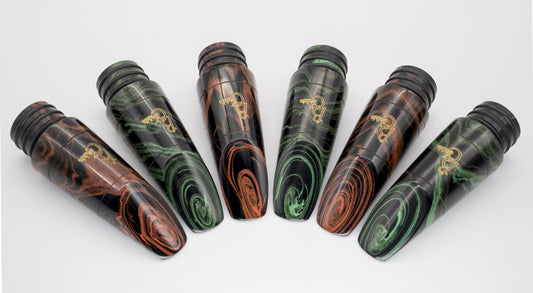Breaking In Your Clarinet
In order to reduce the likelihood of cracking and help stabilize the instrument, it’s important that moisture is reintroduced to the clarinet in a controlled manner. Remember, this piece of wood was part of a tree. It naturally wants to be a tree, not a clarinet. We must help “re-educate” this piece of wood for our own purposes so that it may give us joy for years to come! This applies to all new wooden clarinets and instruments that have not been played for some time (new-to-you).
Brian's Procedure
- Play daily for 15 minutes at a time, twice a day for a maximum of 30 minutes a day for the first week. It is important to avoid skipping days, as consistent daily playing is crucial for proper break in.
- Increase your playing session by 5 minutes each week, so that you are playing for 30 minutes at a time, up to 1 hour a day, by week 4.
-
Swab every 5 - 10 minutes during your practice session, especially in the first several weeks of the break in process.
Allow the clarinet to rest for at least 1 hour between your practice sessions, ensuring there is no moisture inside the bore or sockets - Continue this process for several months, understanding that your clarinet will continue to break in and change for up to 1 or 2 years.

Do's and Don'ts
DO keep your clarinet case humidified, especially if your natural environment has low humidity. There are a myriad of products available, but an accurate hygrometer is essential to keep track of the humidity.
DO NOT play or blow warm air through your clarinet if it is cold to the touch. This is a dangerous way to warm up your clarinet and will undoubtedly do more harm than good.
DO warm up a cold clarinet from the outside by placing the upper and lower joint gently in your underarm. Your body heat will bring the clarinet up to temperature in a matter of minutes without shocking the wood.
DO NOT forcefully assemble your clarinet if you notice it is more difficult than usual to assemble (with cork grease). This can be caused by wood movement in either direction, such as a swollen tenon or a shrunken socket.
DO check the fit of the metal rings around your barrel, socket, or bell if applicable. Rings can become loose if the wood underneath has shrunk as a result of dry or cold conditions. A qualified technician can easily resolve this issue, but temporary measures such as applying a paper shim between the ring and wood can help.
DO NOT leave any moisture inside your clarinet after you are done playing. Swab your instrument until all inner moisture is removed, and DO NOT forget the sockets of your barrel, lower joint, and bell.
DO dry your pads / tone holes with cigarette paper, and blow the water out of your tone holes (especially the trill keys) by creating a seal with your hand or a rubber plug and opening individual keys while blowing through the bore.
Remember, your miles may vary. No matter how careful you are, sometimes a clarinet will crack because that's what they do! Before you blame the manufacturer, the model, your climate, etc., make sure you are doing everything in your power to give your clarinet the best chance to thrive for many decades. Don't forget the regular maintenance ( I recommend sending your clarinet in to your technician at LEAST twice a year!).








